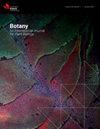基于重复DNA和基因组学的松茸及其相关物种的生物多样性。
IF 1
4区 生物学
Q3 PLANT SCIENCES
引用次数: 0
摘要
松茸及其相关物种是外生菌根真菌,生产珍贵的蘑菇,统称为“松茸”。这些蘑菇主要分布在北半球。在这篇综述中,我们描述了我们对松茸分布和进化的理解的开创性工作和最新进展,特别关注基因组研究。DNA序列分析显示,杯形T.caligatum是这一群体中最早的物种,其次是富尔瓦斯坦T.fulvocastaneum,与伊尔科T.ilkkae、杜尔西奥伦斯T.dulciolens和巴卡马苏塔克T.bakamatsutake的集群,最后是与穆里利亚纳姆T.murrillianum、中美洲T.mesomericanum、锐钛矿T.anatolicum和松茸T.matsutake的集群。尽管基于移动DNA和全基因组序列的分析揭示了相似的聚类模式,但巴松和松茸的移动DNA分布和基因组结构存在明显差异。此外,重复DNA可以用作区分来自不同地理区域的松茸菌株和种群的标记,包括识别担孢子的分散体。“端粒到端粒基因组测序”分析发现,松茸和bakamatsutake在其基因组内经历了反转录转座子的爆炸性繁殖,但它们之间扩展了不同的可移动DNA元件。与此相反,松茸和巴卡松茸交配基因座的结构是高度保守的。本文章由计算机程序翻译,如有差异,请以英文原文为准。
Biodiversity of Tricholoma matsutake (syn. T. nauseousm) and its related species based on repetitive DNA and genomics.
Tricholoma matsutake and its related species are ectomycorrhizal Agaricomycetes that produce prized mushrooms collectively called “matsutake.” These mushrooms are mainly distributed in the Northern Hemisphere. In this review, we describe both the pioneering work and recent advances in our understanding of the distribution and evolution of matsutake, with a special focus on genomic studies. DNA sequence analyses revealed that T. caligatum was the earliest species within this group, followed by T. fulvocastaneum, the cluster with T. ilkkae, T. dulciolens, and T. bakamatsutake, and finally the cluster with T. murrillianum, T. mesoamericanum, T. anatolicum, and T. matsutake. Although analyses based on mobile DNAs and whole-genome sequences revealed a similar clustering pattern, there are distinct differences in the distribution of mobile DNAs and genomic structure of T. bakamatsutake and T. matsutake. Furthermore, repetitive DNA can be used as markers to distinguish among strains and populations of T. matsutake from different geographical regions, including identifying dispersals of basidiospores. “Telomere-to-telomere genome sequencing” analyses unearthed that both T. matsutake and T. bakamatsutake underwent explosive multiplications of retrotransposons within their genomes but with different mobile DNA elements expanded between them. Contrastingly, the structure of the mating loci between T. matsutake and T. bakamatsutake is highly conserved.
求助全文
通过发布文献求助,成功后即可免费获取论文全文。
去求助
来源期刊

Botany
生物-植物科学
CiteScore
2.20
自引率
9.10%
发文量
48
期刊介绍:
Botany features comprehensive research articles and notes in all segments of plant sciences, including cell and molecular biology, ecology, mycology and plant-microbe interactions, phycology, physiology and biochemistry, structure and development, genetics, systematics, and phytogeography. It also publishes methods, commentary, and review articles on topics of current interest, contributed by internationally recognized scientists.
 求助内容:
求助内容: 应助结果提醒方式:
应助结果提醒方式:


